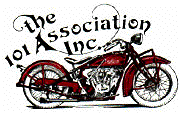Interesting to take the heads off a 93 year old 101 and see the valves stamped “Thompson / Indian / MC.”
Note the punch marks to maintain specific placements (see accompanying images).
Oral history tells that this 1931 101 was not heavily used during its life in Sweden by its 5 past successive owners there. And got attention just once in its life, in the 1970’s, with a reported engine rebuild. But could these be the original valves reused or were replacement valves at the time stamped “Indian”?
What about the pistons stamped “7450?”
These pistons do not reach TDC flush with the cylinder wall tops but fall short of that at TDC by 0.12 in. or about 3 mm. I measure this and advance timing using stacks of washers, which normally vary in thickness, building stacks that fill the distance and then I use a micrometer to measure the stacks.
I opened up to re-time the engine, timing which our local “Indian mechanic” did wrongly. This engine ran great until he worked on it. I have no problems replacing Scout magnetos myself but I was tired of shop work last fall and sent the bike to him to install a rebuilt Bosch DVAR magneto.
He returned it with advance timing set to piston going past TDC, and full retard ignition occurred when the piston was about an inch down on its way into its power stroke!
The bike started and idled OK but had no power and had to be fully advanced to move it. He claimed he test rode it and it was “the best riding Indian Scout he ever tried.”
I asked if he looked at the pistons to determine timing and he replied “no.” I can’t put words in his mouth nor recall exactly what he added but it was something like he timed it from the cams. I don’t know how to do that – I have to see what the pistons are doing.
And like documenting these valves and piston stampings, its good to look for yourself! I also found quite a carbon buildup to clean off.
Advancing the magneto drive gear one cog from where the “mechanic” set it I measure the top of the pistons, at full advance, are at .305 in. down from piston TDC at ignition (measured with a point breaking light from The Magneto Guys) - not quite enough advance. Again, that .305 in. is measured based on piston travel not distance from top of cylinder walls since the pistons reach TDC short of the tops.
And advanced two cogs the pistons are .495 in. down from piston reaching TDC on full advanced ignition – a bit too much advance.
I choose to set the timing at the .495 advance. Because the control cable pushes down on the magneto ring to advance timing, I can set the throw of that with some load that limits the remaining throw to avoid so much advance.
Any comments on this?
Thanks.


